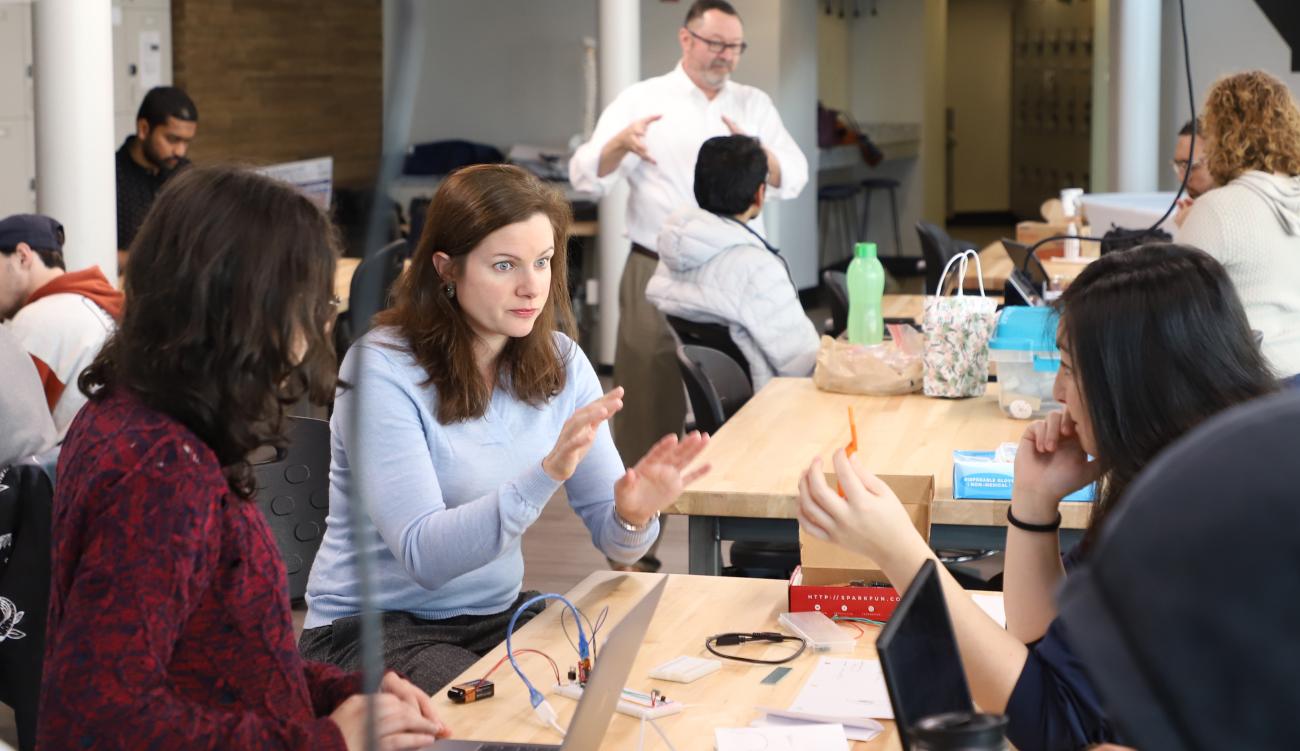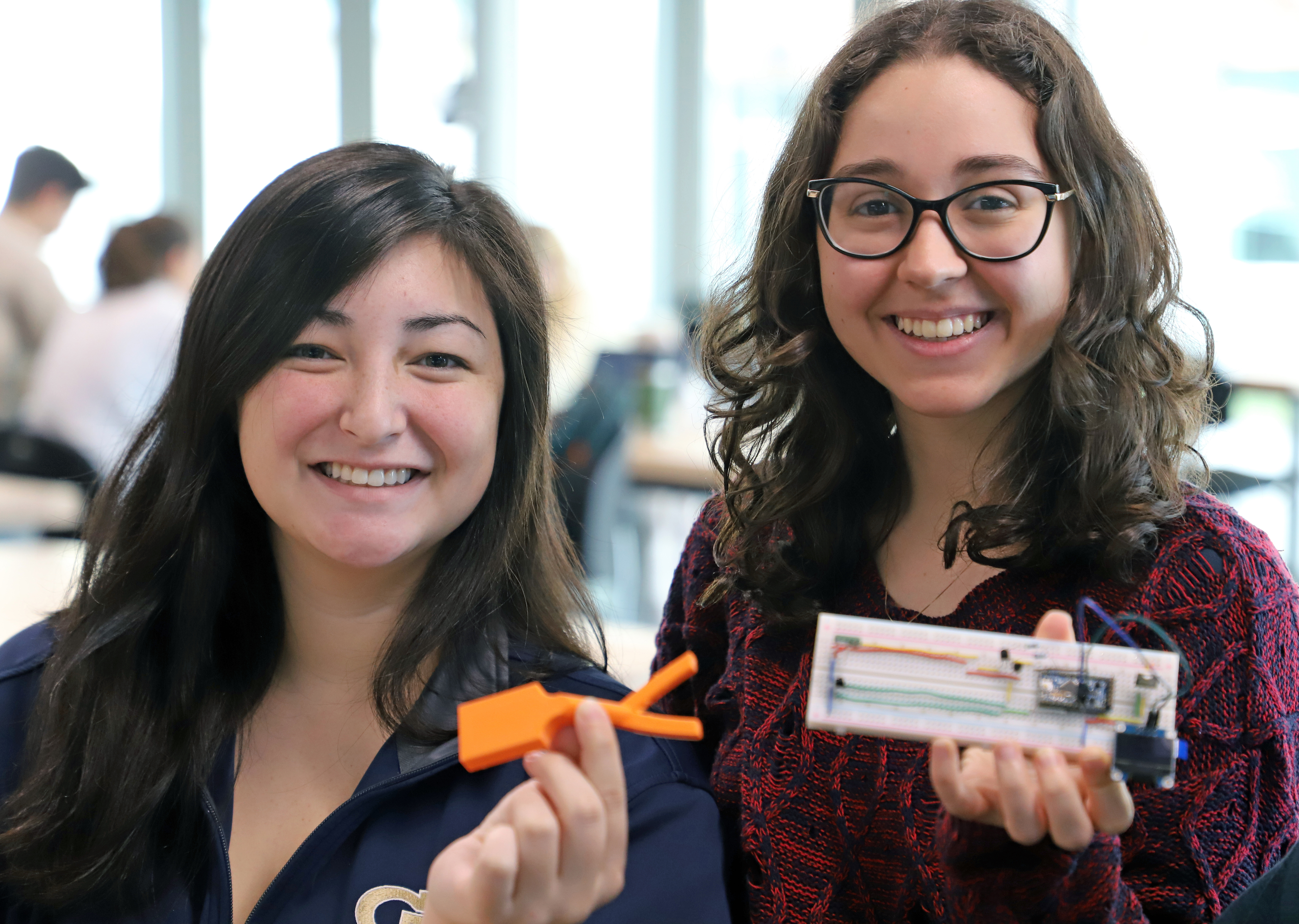By Jerry Grillo
On a bright Atlanta morning in the busy BME Design Garden, Allie Barone was drawing a picture on a pad of paper. Something serious and functional. Not a cartoon or caricature.
“This is another iteration of our design,” said Barone, a student in the Wallace H. Coulter Department of Biomedical Engineering at Georgia Tech and Emory University. She pointed out elements on the page. “So, this is the front piece of the pulse oximeter that we’re developing. See, it’s sublingual, which means it goes under your tongue.”
Pulse oximeters, which typically clip onto a patient’s index finger, measure the oxygen saturation in a person’s blood, a crucial indication of lung health. In the age of Covid-19, these little devices have become critical and ubiquitous – in the clinic and at home. But it turns out they can be inaccurate when measuring oxygen levels in people with darker skin.
And these faulty measurements have resulted in patients of color receiving less supplemental oxygen than they’ve needed, among other things.
“We saw a lot of that during the Covid pandemic here in the U.S., and it’s a huge problem in developing countries as well,” Barone said. “That one measurement could be the difference between getting a hospital bed, or not. Many patients suffered when they should have been treated or hospitalized. We’d like to prevent that.”
Barone is one of the five undergraduate biomedical engineering students collectively called the Pulse Oxi-mates, one of three teams in the Global Health Capstone program, or GHC. For the past several years, teams of Georgia Tech BME undergrads have collaborated with doctors in low-income regions around the world.
“This program was launched with a clear aim in mind,” said James Stubbs, professor of the practice in the Coulter Department and director of GHC (which falls under the BME Capstone canopy). “That is, our students are trying to make an impact in resource-limited settings by developing medical devices to tackle their unique clinical needs.”
The Pulse Oxi-mates are one of three teams in the GHC, and one of 18 from Coulter BME who will present their projects at the Fall Capstone Expo (Monday, Dec. 5) in the McCamish Pavilion on the Georgia Tech campus. Last fall, 118 teams from across campus showcased their senior Capstone projects at the expo, which featured competitions between online presenters, and live presenters. Monday’s competitive event will be totally live.
Thinking Globally, Acting Locally
The GHC program was developed, in part, to address one of Georgia Tech’s strategic initiatives.
“One of the institute’s key pillars is to connect globally,” Stubbs said. “So, we’ve made a commitment in the global health arena.”
And recently, the program received an internal boost to help sustain that commitment. Georgia Tech’s Global Student Experience program granted Stubbs’ team $15,000 as part of an initial round of support to fund projects and programs related to student global experiences.
The funding will support the work of Kelsey Kubelick, a postdoctoral researcher who co-founded GHC with Stubbs. Kubelick, who works in Stanislav Emelianov’s Ultrasound Imaging and Therapeutics Research Lab, earned her Ph.D. from Coulter BME in 2020. She has split her time between her own research and helping to lead the GHC program.
“A big part of my role is finding ways to grow the program and find new and different opportunities for our students to have that global health engineering experience, to travel to these environments and gain an understanding of the local clinical needs,” said Kubelick.
In the past, the program was focused almost entirely on clinical needs in Ethiopia, building on the work of BME Associate Professor Rudy Gleason. Teams of BME students have created devices focused on the needs of at-risk infants in that country. With the help of new sponsors, such as Neonatal Rescue and Task Force for Global Health (TFGH), the Global Health Capstone program is expanding its geographic focus.
Neonatal Rescue is focused on developing respiratory therapeutic solutions specifically for low-resource settings.
“Our students contacted Neonatal Rescue when they were researching user needs,” Kubelick said. “So, this is an example of our students taking initiative and ownership, helping us find new directions for our work.”
Neonatal Rescue is sponsoring two of the Global Health Capstone teams from BME, including the Pulse Oxi-mates. The third team is sponsored by TFGH, specifically the Children Without Worms division, to develop tools to improve diagnosis of intestinal worms. Working with these organizations, Kubelick said, students have identified opportunities to address clinical needs in other countries (such as Cambodia, Tanzania, and Zambia).
“These organizations want to work with us to help give our students in-country experiences,” Kubelick said. “Our new funding will help us build those partnerships with sponsors and explore those opportunities in new countries, so we can plan to take our students there.”
Life-Changing Projects
In the meantime, teams like Pulse Oxi-mates did their discovery work from a distance, contacting physicians in other countries to determine the unmet clinical needs.
“For example, we interviewed physicians in Angola, Cambodia, Zambia, and Brazil, which is where I’m from,” said Giuliane Fuzetto Paschoal of the Pulse Oxi-mates, whose teammates include Barone, Hirschel Nambiar, Marshall Nambiar, and Rahul Shah. “It was fascinating to hear their stories and learn about their struggles. And also inspiring.”
It’s those stories that drew the students in, “the idea that we’d be able to work on a device that could be implemented in a country that really needs it, a place with less access to health care technology,” said Marshall Nambiar.
His brother Hirschel added, “The biggest thing is that we have the opportunity to work on a potentially life-changing project, not only targeting communities in other countries, but also here in the U.S., where we have many people that lack access to affordable care or medical devices.”
Particularly for people of color, skin pigmentation can affect a pulse oximeter’s accuracy in measuring oxygen saturation – an inaccuracy that may also be connected with disparities in care, according to recent research from Harvard Medical School. Black, Hispanic, and Asian patients had greater differences between blood saturation levels detected by pulse oximeters versus measurements from blood draws. These patients subsequently received less supplemental oxygen than white patients.
“The standard method uses light to read oxygen saturation in the blood and that light can be absorbed by the melanin, not by the blood, in patients with darker skin,” said Barone. “But we are circumventing that problem because our device goes under the tongue, where there is an artery that we can target, and we can get more accurate readings.”
Latest BME News
Jo honored for his impact on science and mentorship
The department rises to the top in biomedical engineering programs for undergraduate education.
Commercialization program in Coulter BME announces project teams who will receive support to get their research to market.
Courses in the Wallace H. Coulter Department of Biomedical Engineering are being reformatted to incorporate AI and machine learning so students are prepared for a data-driven biotech sector.
Influenced by her mother's journey in engineering, Sriya Surapaneni hopes to inspire other young women in the field.
Coulter BME Professor Earns Tenure, Eyes Future of Innovation in Health and Medicine
The grant will fund the development of cutting-edge technology that could detect colorectal cancer through a simple breath test
The surgical support device landed Coulter BME its 4th consecutive win for the College of Engineering competition.









